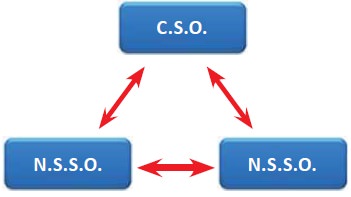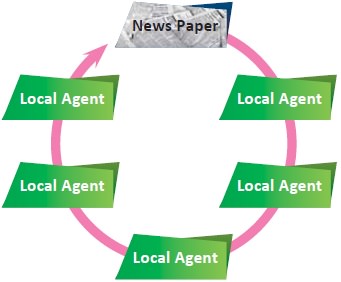Statistics - Methods of collecting primary data | 11th Statistics : Chapter 2 : Collection of Data and Sampling Methods
Chapter: 11th Statistics : Chapter 2 : Collection of Data and Sampling Methods
Methods of collecting primary data
Methods
of collecting primary data
In this section, we present different methods of collecting
primary data. In this context, we define an Investigator or Interviewer as one
who conducts the statistical enquiry and the person from whom the information
is collected is called a Respondent.
The primary data comes in the following three formats.
i.
Survey data: The investigator or
his agency meets the respondents and gets the required data.
ii.
Experimental data (field/laboratory):
The investigator
conducts an experiment,
controlling the independent variables and obtains the corresponding values of
the dependent variable.
iii.
Observational data: In the case of a
psychological study or in a medical situation, the
investigator simply observes and records the information about respondent. In
other words the investigator behaves like a spectator.
The various methods used to collect primary data are:
i.
Direct Method
ii.
Indirect Method
iii.
Questionnaire Method
iv.
Local Correspondents Method
v.
Enumeration Method
1. Direct Method:
There are three methods under the direct method
(a) Personal Contact Method
As the name says, the investigator himself goes to the field,
meets the respondents and gets the required information. In this method, the investigator
personally interviews the respondent either directly or through phone or
through any electronic media. This method is suitable when the scope of
investigation is small and greater accuracy is needed.
Merits:
·
This method ensures accuracy because of personal interaction
with the investigator.
· This method enables the interviewer to suitably adjust the situations with the respondent.
Limitations:
·
When the field of enquiry is vast,this method is more expensive,
time consuming and cumbersome.
·
In this type of survey, there is chance for personal bias by the
investigator in terms of asking ‘leading questions’.
(b) Telephone Interviewing
In the present age of communication explosion, telephones and
mobile phones are extensively used to collect data from the respondents. This
saves the cost and time of collecting the data with a good amount of accuracy.
(c) Computer Assisted Telephone Interviewing (CATI)
With the widespread use of computers, telephone interviewing can
be combined with immediate entry of the response into a data file by means of
terminals, personal computers, or voice data entry. Computer – Assisted
Telephone Interviewing (CATI) is used in market research organizations
throughout the world.
(d) Computer Administered Telephone Survey
Another means of securing immediate response is the
computer-administered telephone survey. Unlike CATI, there is no interviewer. A
computer calls the phone number, conducts the interview, places data into a
file for later tabulation, and terminates the contact. The questions are voice
synthesized and the respondent’s answer and computer timing trigger
continuation or disconnect. The last three methods save time and cost, apart
from minimizing the personal bias.
2. Indirect Method:
The indirect method is used in cases where it is delicate or
difficult to get the information from the respondents due to unwillingness or
indifference. The information about the respondent is collected by interviewing
the third party who knows the respondent well.
Instances for this type of data collection include information
on addiction, marriage proposal, economic status, witnesses in court, criminal
proceedings etc. The shortcoming of this method is genuineness and accuracy of
the information, as it completely depends on the third party.
3. Questionnaire Method
A questionnaire contains a sequence of questions relevant to the
study arranged in a logical order. Preparing a questionnaire is a very
interesting and a challenging job and requires good experience and skill.
The general guidelines for a good questionnaire:
·
The wording must be clear and relevant to the study
·
Ability of the respondents to answer the questions to be
considered
·
Avoid jargons
·
Ask only the necessary questions so that the questionnaire may
not be lengthy.
·
Arrange the questions in a logical order.
·
Questions which hurt the feelings of the respondents should be
avoided.
·
Calculations are to be avoided.
·
It must be accompanied by the covering letter stating the
purpose of the survey and guaranteeing the confidentiality of the information
provided.
Editing the preliminary questionnaire
Once a preliminary draft of the questionnaire has been designed,
the researcher is obligated to critically evaluate and edit, if needed. This
phase may seem redundant, given all the careful thoughts that went into each
question. But recall the crucial role played by the questionnaire.
Pre Test
Once the rough draft of the questionnaire is ready, pretest is
to be conducted. This practice of pretest often reveals certain short comings
in the questions, which can be modified in the final form of the questionnaire.
Sometimes, the questionnaire is circulated among the competent investigators to
make suggestions for its improvement. Once this has been done and suggestions
are incorporated, the final form of the questionnaire is ready for the
collection of data.
Advantages:
·
In a short span of time, vast geographical area can be covered.
·
It involves less labor.
Limitations:
·
This method can be used only for the literate population.
·
Some of the mailed questionnaires may not be returned.
·
Some of the filled questionnaires may not be complete.
·
The success of this method depends on the nature of the
questions and the involvement of the respondents.
4. Local Correspondents Method
In this method, the investigator appoints local agents or
correspondents in different places. They collect the information on behalf of
the investigator in their locality and transmit the data to the investigator or
headquarters. This method is adopted by newspapers and government agencies.

For instance, the Central Statistical Organization (CSO) of
Government of India has local correspondents NSSO. Through them they get the
required data. Newspaper publishers appoint agents to collect news for their
dailies. These people collect data in their locality on behalf of the publisher
and transmit them to the head office.

This method is economical and provides timely information on a
continuous basis. It involves high degree of personal bias of the
correspondents.
5. Enumeration method:
In this method, the trained enumerators or interviewers take the
schedules themselves, contact the informants, get replies and fill them in
their own hand writing. Thus, schedules are filled by the enumerator whereas
questionnaires are filled by the respondents. The enumerators are paid
honorarium. This method is suitable when the respondents include illiterates.
The success of this method depends on the training imparted to the enumerators.
The voters’ list preparation, information on ration card for public
distribution in India, etc., follow this method of data collection. National
Sample Survey Office (NSSO) collects information using schedules depending on
the theme.
Related Topics